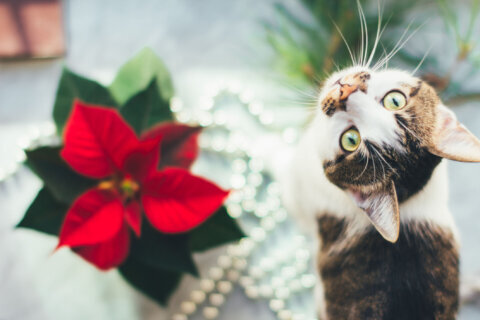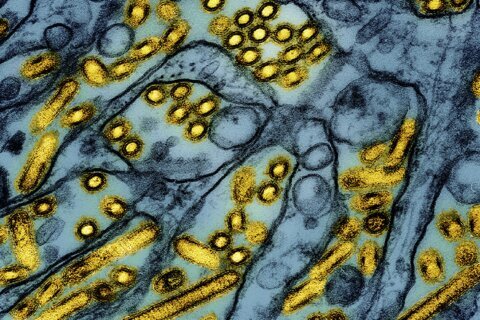FOREST PARK, Illinois (AP) — Mayumi Barrack sees a pair of mating periodical cicadas getting together, whips out her phone, says, “Hi guys!” and takes their picture.
“I’m not really a bug person, but as I look more and more I feel they are adorable,” Barrack explained, noting that many other creatures — birds, squirrels, raccoons and more — are just as eager to get close to the bugs, if only to turn them into food. “I just want to document they existed.”
And boy has she. Barrack has posted more than 4,600 photos of the bugs on the Cicada Safari app for cicada enthusiasts. That’s 2,000 more than her nearest competitor. She’s the queen of cicada chasers, though she doesn’t really chase — most of the pictures are from her backyard — and she sees herself more as a mother to the bugs than as a queen.
“I’m caring for them,” said Barrack, standing in her tree-and-flower filled suburban Chicago backyard.
Periodical cicadas are strange, with eccentricities that include super-strong urine flow and a zombie fungus infection. But their superfans are unusual, too, or at least highly passionate.
Gene Kritsky, a professor of biology at Mount St. Joseph University in Cincinnati, has been working toward this year’s massive cicada emergence for decades. He first heard about cicadas in 1972 and has been studying and chasing them since 1974. He wrote the book on the current emergence, “A Tale of Two Broods.” He also created the cicada tracking app that enthusiasts like Barrack use to post pictures and find where the bugs are in large numbers.
This is the third time Kritsky has mapped Brood XIII of the cicadas. That’s quite an accomplishment since they only come out every 17 years.
Often wearing a safari hat that makes him look like the Indiana Jones of cicadas, which he has been called, Kritsky and his artist wife Jessee Smith have driven back and forth from Ohio to Illinois several times this spring to revel in the bugs. Over several long nights at a forest north of Chicago, he’s seen massive numbers including his first one-in-a-million blue-eyed cicada. He cited the May 24 emergence as “incredible” with thousands coming out that night at his location.
“Periodical cicadas are the gateway drug to natural history,” Kritsky said.
For New York City chef Joseph Yoon, cicadas aren’t just amazing, they’re dinner. His Brooklyn Bugs company is on a mission to spread the word about the taste and sustainability of edible insects, though he knows many people are grossed out by the thought.
Yoon spent nine days in Illinois collecting, freezing and then bagging tens of thousands of cicadas. After getting back home, he served up tempura cicada to 400 people at a Syracuse University event.
Yoon said collecting and cooking cicadas “is quite painful for me because I love the cicada so much.”
But he added: “At the same I also can acknowledge and appreciate that each one of these cicadas’ lives represents a potential to transform somebody’s perception or opinion about eating insects.”
Yoon’s friend, Wisconsin artist and professor Jennifer Angus, also sees the beauty in cicadas and other insects — so much so that she incorporates the actual bugs into her art. Sometimes she put them in outfits and posed them as dolls.
“I love them because they just have great faces and bulging eyes and they’re very hardy,” Angus said. “They stand up to the wear and tear at my exhibitions.”
“I find their faces humorous,” Angus said.
Renee Martin teaches interior design at the University of Kentucky and also dabbles in puppetry. For a Cincinnati puppet festival three years ago — when Brood X was making big news on the East Coast — someone suggested she come up with a cicada costume or puppet.
“What would I do? A cicada strip-tease?” she asked her friends, who gave a resounding yes.
She worked up “something between a puppet and a costume” for that festival, then hauled it out again for this year’s big emergence, putting on a show in a Cincinnati alley for friends, neighbors and visiting journalists.
Martin, wearing faux fishnet stockings and moving comically to stripper music, starts out as a cardboard pale nymph and then bursts through as a red-eyed adult nymph. The audience added to the effect with noisemakers and cries of “ooh la la” and “sexy cicada.”
Meanwhile, photos of cicadas are swarming in to Kritsky’s app, with nearly 5,000 people posting. About 150 people have posted at least 100 cicada pictures, but none are close to Barrack — who said she’s surprised to be leading.
“I have so many pictures I haven’t sent yet,” she said.
___
This story has corrected Renee Martin’s subject area at the University of Kentucky.
___
Follow Seth Borenstein on X at @borenbears
______
The Associated Press’ climate and environmental coverage receives financial support from multiple private foundations. AP is solely responsible for all content. Find AP’s standards for working with philanthropies, a list of supporters and funded coverage areas at AP.org.
Copyright © 2024 The Associated Press. All rights reserved. This material may not be published, broadcast, written or redistributed.







